The actions of the forces of the Northern Fleet in the Petsamo-Kirkenes operation
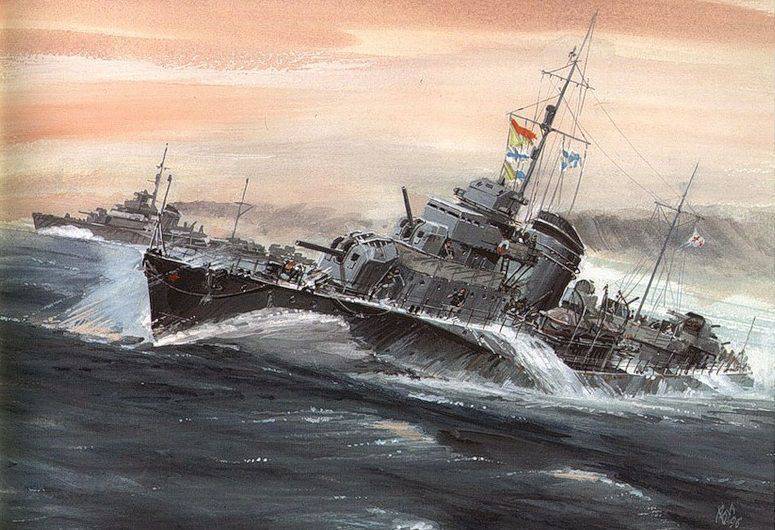
The Petsamo-Kirkenes operation conducted by the forces of the 14th Army of the Karelian Front and the forces of the Northern fleet (SF), was carried out in the period from October 7 to October 31, 1944. At sea, Germany still had a significant grouping. By the beginning of October, the Tirpitz battleship, 13-14 destroyers, about 30 submarines, more than 100 minesweepers, torpedo boats and patrol ships, over 20 self-propelled barges, 3 air defense ships, 2 mine loaders and others were stationed at naval bases in Northern Norway. strength. In front of the units entering the Northern Defensive Region (NOR) of the fleet, on Sredniy Peninsula, the enemy concentrated about 9000 soldiers and officers, 88 guns, 86 mortars, and also fire weapons. The German fleet continued its active struggle against our convoys, but its main efforts were focused on the tasks of protecting its shipping, which during the evacuation of troops and equipment and the export of strategic raw materials from the Arctic became particularly important.
The NOR fleet, which occupied the defensive lines on the Peninsulas of the Fishermen and the Middle, included the 12-I and 63-I brigade of marines, the coastal artillery division, the 3 individual machine-gun and artillery battalion and one artillery regiment (10500 man in total).
To participate in the upcoming operation, the Northern Fleet under the command of Admiral AG Golovko singled out (for the landing of landings and actions on the sea direction) one leader, 4 squadron destroyer, 8-10 submarines, over 20 torpedo boats, up to 23 large and small hunters and 275 aircraft.
In accordance with the developed plan of the Petsamo-Kirkenes operation, agreed upon during a meeting of the command of the Karelian Front and the Northern Fleet, Admiral A.G. Golovko was tasked with the following: fleet units to begin active operations in the maritime as well as coastal areas. According to the operation plan, which was given the code name “West”, aviation The Northern Fleet, submarines, torpedo boats and destroyers in the maritime direction had to prevent the evacuation of German troops by sea, using the ports of the Varanger fjord in the Kirkenes-Hammerfest section, to destroy all boats when they attempt to leave by sea. In the coastal direction, the combat units and formations of the SOR (commander Major General E.T. Dubovtsev) should have broken through the German defenses on the isthmus of the Sredny Peninsula, seized the road to Petsamo and prevented the withdrawal of German troops, and then launched an attack on the Pechenga, in close cooperation with parts of the 14th army. It was also planned to assist the coastal flank of the ground forces, landing amphibious assault forces behind enemy lines, on the shores of Malaya Volokovaya Bay, on the Norwegian coast near Kirkenes and in the port of Liinahamari.
The offensive of our troops began on October 7. After fierce two-day battles, the formations and units of the 14 Army managed to break through the German defenses, forcing the r. Titovka and continued offensive. Leading fierce battles for the roads, the Nazis on the night of October 10 began to withdraw. By this time, the navy was in full readiness for landing at the Malaya Volokovaya Bay. On 19 submarine hunters and 12 torpedo boats, the 3000 paratroopers of the 63 Brigade of the Marine Corps sank, and in the evening of October 9, three detachments from Zemlyanoy, they set sail. At 23 hours, the first squadron (7 small hunters, 2 torpedo boats with 700 paratroopers on board), commanded by guard captain 3 rank SD. Zyuzin, went to the landing site. Under the fire of enemy batteries, the ships illuminated by searchlights broke through to the shore and, covered with smoke screens and our artillery fire, landed troops, whose composition included reconnaissance detachments of the SF and SOR headquarters, which had the task of seizing the German artillery batteries located on Cape Krestovy and ensuring the landing of the landing force in Liinakhamari. The group of boats from which the reconnaissance sailors landed was commanded by Senior Lieutenant B.M. Lyah.
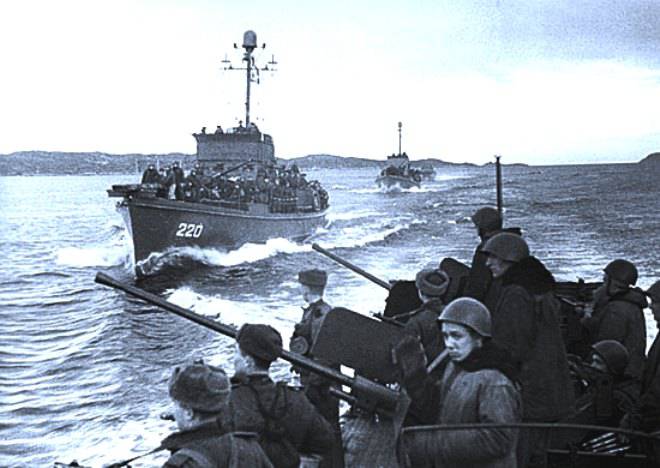
11 large second-class hunters under the command of captain 3 rank I.N. Gritsuk was brought to the mouth of Malaya Volokovaya by the main landing forces (1628 man). Under the shelling of enemy coastal batteries, having a relatively large draft, the boats could not immediately approach the coast, because of which the landing of the second echelon of the landing force was somewhat delayed.
The commander of the third troop unit, consisting of 8-torpedo boats and one small hunter, captain 2 rank VN Alekseev did not expect the end of the landing of the second echelon. Boats at full speed went to the shore, dodging the enemy artillery fire. After disembarking his landing group (672 man), a detachment of Alekseev hurried to big hunters and helped land the main forces, using his boats as improvised floating moorings. By one in the morning of October 10, the entire 63 I brigade of marines was parachuted. Moreover, her losses amounted to all 6 fighters. Success was ensured by surprise, high landing rates and demonstrative landing in Motovka Bay. Leaving one battalion to defend the captured bridgehead, the 63 I brigade immediately launched an offensive in the direction to the southeast. By 10 hours of the morning she went to the flank of the enemy defense on the ridge of Musta-Tunturi. The joint reconnaissance detachment headed along the tundra to the Krestovoy metro station.
The offensive of the COP began from the front in the early morning hours of October 10. At half past three, the artillery of the 113 Division, which was part of the 104 Gun Regiment, the Loud and Thunder squadrons, began firing training for one and a half hours. During this period of time, along the leading edge, command posts, reserves and batteries of the enemy, only COP artillery (209 barrels), 47000 shells and mines were fired. Under the cover of fire, the 12-I brigade of marines, the 338-th engineering battalion, the 508-I engineering-landing company and other naval units attacked the fortified positions of the Nazis.
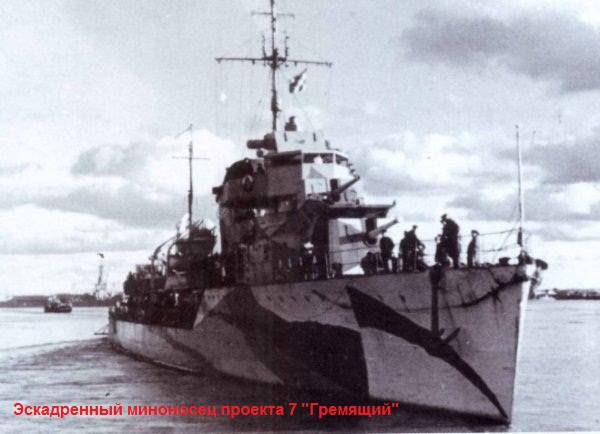
The task was complicated by the fact that at night from 8 on October 9, snow fell to 30 cm thick. By the time the attack began, a strong snowstorm had risen. The icy bare rocks of Musta-Tunturi became almost impregnable. All this greatly hampered the advancement of troops and orientation on the terrain. However, soldiers of the 12 th brigade of the marines, overcoming enemy barriers, strong rifle, artillery and mortar fire, by 12 hours broke through the defenses, crossed the ridge of Musta-Tunturi and joined the 63 brigade, which attacked the fascists with you. The fights were fierce. In them, the sailors showed courage and heroism. For example, in a difficult moment of attack Sergeant A.I. Klepach covered the embrasure of the fascist dota with his chest. By sacrificing his life, he ensured the success of the unit.
By the end of the second day of the offensive, the Marines had cut Titovka-Porovara road. However, the rate of attack was low, artillery lagged behind. The lack of experience of offensive battles in the dark period of the day, lack of preparedness of the marines for the night march. As a result, the Nazis were able to break away from the Soviet units during the night of October 11. In the evening of October 13, the units of the 63 Brigade, meeting with the units of the 14 Rifle Division of the 14 Army, came to Porovaraar. The 12 Brigade headed for Cape Cross. At dawn of 14 in October, the troops of the 63 Brigade, overcoming enemy resistance, occupied Porovara and came to the shore of the Pechenga Bay.
Joint reconnaissance under the command of captain I.P. Barchenko-Emelyanov night 12 October was able to go unnoticed at the cape. Cross, where he attacked the enemy and after a brief battle, captured the 4-gun 88-mm anti-aircraft battery, and then blocked the neighboring four-gun 150-mm battery, which locked the entrance to the ships in the Pechenga Bay. After arriving at the aid of a detachment of enhanced marines reconnaissance, the garrison of the battery in the morning of October 13 capitulated. This success deprived the Germans of the opportunity to oppose the forces of the fleet from one of the directions, which made it possible to make a landing in Liinakhamari.
The port of Liinakhamari, located on the west coast of the Pechenga Bay, was used by the fascists as a transshipment base for the supply of its troops. On the approaches to the port, the Nazis created a strong antiamphibious defense, which included 4 large-caliber batteries, several batteries of automatic guns, as well as a significant number of pillboxes and other engineering structures. The entrance to the harbor was covered by anti-submarine barriers.
The plan of the fleet commander for the landing of troops in this port as a whole was part of the overall plan of the offensive of the 14 Army units on Petsamo. The assault force helped the troops to ensure the speedy release of the port and the destruction of the remnants of the defeated Nazi units that were trying to retreat to Norway.
To land a detachment of marines (660 man) commanded by Major I.A. Timofeev, it was decided the night of October 13. The paratrooper was faced with the task of capturing the 210-mm battery at Cape Devkin and the dominant heights, to seize the port, the military town and hold these objects until the main forces of the NOR approach. Also, with the aim of enhancing the landing force and further developing the success, the delivery of 12 and 63 teams to the port of the marines was planned. The assault force landed on 14 torpedo boats and small hunters. The landing and combat operations of the landing party on the shore were carried out under the direct supervision of the fleet commander located at the auxiliary command and control post.
On the approach to the Pechenga Bay, intensive artillery fire fell on the first group of boats. Further actions of all three groups were also carried out under heavy shelling. Each group was forced to break through to the coast on their own, using the curtains installed by torpedo boats, constantly maneuvering the course and speed. Despite this, the landing was carried out mainly at scheduled points. The first group finished it at 23 hours, the second and third at 24 hours. A total of 552 people landed in the port area.
Without waiting for the dawn, the paratroopers attacked a strongly fortified stronghold, which covered the firing position of the artillery battery. Detachment of Art. Lieutenant B.F. Petersburg began to move southwest. By dawn, the fascists, having received reinforcements, counterattacked, and a difficult situation developed for the landing force. The fleet command to help the marines sent a group of aircraft captain P.A. Evdokimova. During the storming of positions, they destroyed up to 200 fascists and 34 car. Having regrouped their forces, our paratroopers resumed the offensive. On October 13, the port of Liinakhamari was liberated, the enemy lost the opportunity to evacuate his units by sea, and our fleet improved the basing of its forces.
October 15 Soviet troops occupied the city of Petsamo. A further offensive was carried out in the direction of Nickel, Nautsi and along the Petsamo-Kirkenes road. Together with the units of the Red Army, the Northern Fleet was to liberate the territory of Northern Norway from the Germans.
The fascists had several strongholds on the coast near their coastal defense batteries, which could pose a threat to the right flank of the advancing 14 army. The current situation has set the fleet new tasks to cover the flank of the 14 Army, cleanse the coast from the enemy and provide troops with ammunition, food and replenishment. By October 25 completed the formation of the Pechenga naval base. By this time, its main parts were relocated to Liinakhamari. To ensure the antiamphibious and ground defense base, as well as military operations in the Kirkenes direction, the 12 Brigade of the Marine Corps was transferred to the base commander. The remaining parts of the COP were transported to Zemlynoe and organized a defense on the Peninsula Fishing and Medium.
18-25 in October, the Federation Council, in order to cover the flank of the ground forces and assist them in offensive operations on Kirkenes, landed three tactical amphibious assault forces on the southern bank of the Varanger Fjord. The first landing of the 12 fighters (486 man) was landed in two groups on the morning of October 18 in the bays of Surrendered-Vuono and Ares-Vuono. The next day, having captured Turunen, Afanasyev and Vuoremi, he reached the state border with Norway. The 3 th battalion of the same brigade, together with a separate detachment of marines of the 195 regiment (626 man), crossed to the coast from boats in Cobbholbn on October 23, in conjunction with the first assault that launched the offensive, cleared the coast from the state border to Yar Fjord .
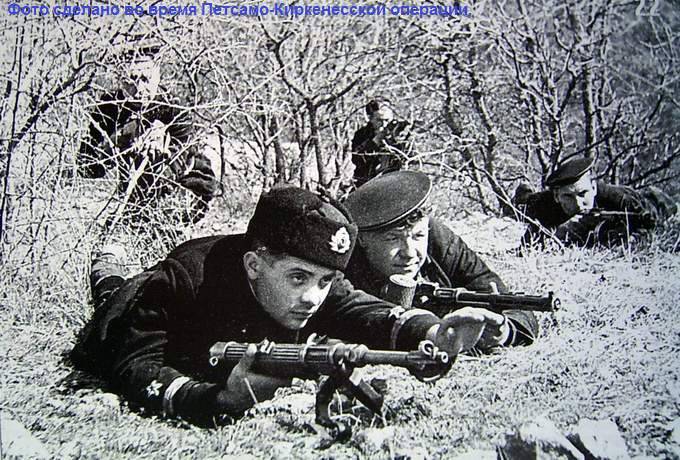
After the withdrawal of the 14 Army of October 24 to Kirkenes, the Commander of the Northern Fleet decided to land a naval landing in the Holmengro-fjord bay. He was tasked with distracting and dragging off part of the enemy forces, creating a threat to the rear of the Germans and thereby assisting ground troops in the assault on Kirkenes. October 25 morning torpedo boats 12 and 3 sea hunter under the overall command of the captain 1 rank A.V. Kuzmin landed two battalions of marines in Holmengro-fjord.
Actively acted during the whole operation of the fleet aviation. It attacked fascist batteries, military equipment, manpower and support points. Attack aircraft and bombers, as a rule, operated in small groups on 6-8 fighter-guided vehicles.
In total, to support the upcoming parts of the CPF and paratroopers, the fleet aviation performed 240 sorties, of which 112 was carried out with the aim of suppressing artillery batteries, and 98 for reconnaissance. In total, the Fleet Air Force held an 42 battle in October, knocking down 56 German aircraft and losing 11 to their own. 138 vehicles were destroyed, about 2000 enemy soldiers and officers, 14 warehouses, 36 anti-aircraft, 13 artillery and mortar batteries suppressed. In general, aviation units completed the task. The combined-arms commanders repeatedly noted the effectiveness of naval aviation strikes.
Military transport carried out by the Northern Fleet during the preparation and direct conduct of the operation was important for the successful operations of the troops. These included the delivery of manpower and equipment of the 14th Army through the Kola Bay, transportation by sea of various types of supplies and ammunition for connecting the coastal flank of the ground forces and the Special Forces, and the evacuation of the wounded. From the 6th of September to the 17th of October, 5719 people, 118 tanks, armored vehicles and self-propelled guns, 153 artillery pieces, 137 tractors and tractors, 197 cars, 553 tons of ammunition and many other various cargoes.
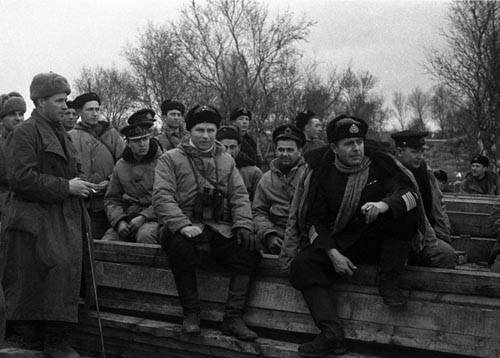
The Northern Fleet rendered considerable assistance to the troops of the 14 Army in the liberation of the Pechenga Region and the regions of Northern Norway in defeating the fascist group. During the operation, parts of the NOR, aircraft and ships of the fleet destroyed about 3000 Nazis, 54 guns and mortars, 65 machine guns, 81 warehouse, captured 108 fascists, captured 43 guns of large and medium caliber, and much more weapons and property.
Along with the actions on the coastal flank of the ground forces, one of the main tasks solved by the Northern Fleet during the Petsamo-Kirkenes operation was a violation of enemy sea shipments along the Norwegian coast, from Varangerfjord to the Hummer-fest. The main objective was to prevent the supply or the possibility of evacuation by sea of enemy troops, the export of nickel and other types of strategic raw materials from the city of Nickel. This task was to be accomplished by submarines, naval aircraft, and torpedo boats, and under favorable conditions, the use of squadron destroyers was assumed. These forces had to destroy transports and warships, destroy port facilities. The plan provided for coordinating the actions of different types of forces and massaging them in limited areas. The operation on the sea communications was led by the fleet commander. Along with centralized control, the commanders of the formations were given initiative to act.
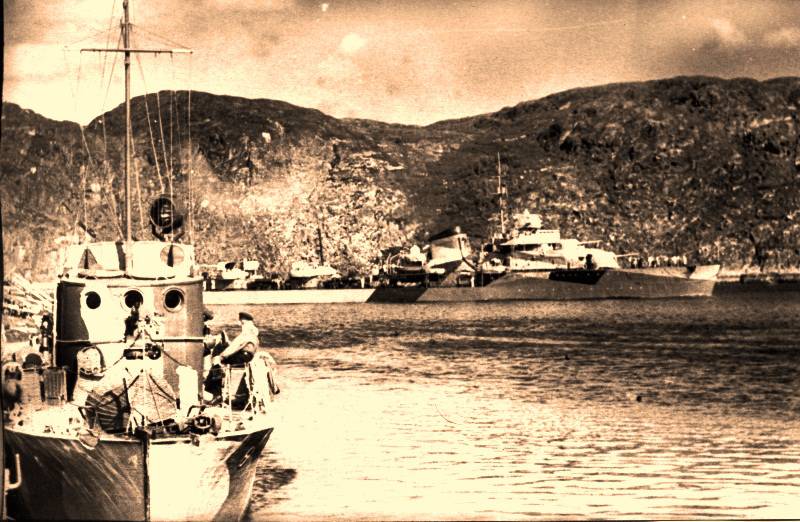
The struggle for communications proceeded in difficult conditions. The weather favored the enemy. The long duration of the dark period of the day (14-18 hours), an extensive network of ports, an abundance of natural anchorage and fjords on the way from Varanger Fjord to the west allowed the Nazis to maneuver the transition time and shelter ships in case of threat of attack. From the end of the summer of 1944, the nazis began to form convoys of 2-3 transport ships in the escort of 5-10 ships, which under cover of darkness made the transition from port to port, from fjord to fjord. The evacuation of the German troops was carried out from the Varanger fjord, mainly from the port of Kirkenes, as well as through the Tanafjord, Laxsefjord and other points. Despite the loss, the traffic intensity has increased dramatically. Only in September, our intelligence revealed at the crossing along the Norwegian coast more 60 convoys.
A team of Soviet submarines searched for enemy convoys in six main areas adjacent to the enemy coast, and acted on complete autonomy. The submarines "B-2", "B-4", "C-56", "C-14", "C-51", "C-104", "C-102", "C -101 ”,“ L-20 ”,“ M-171 ”. The basis of their use was based on the method of hanging curtains. Most of the time, the boats operated in the coastal part of the area, on the routes of convoys, according to the naval reconnaissance aviation guidance data, or conducted an independent search. Changes in their tactics, perseverance in search and decisiveness in the production of attacks contributed to success: in October, our submariners sank 6 transports (with a total displacement of 32 kt), 3 guard and 2 of the minesweeper, damaged 3 of transport (with a total displacement of 19 kt) and 4 the ship. The greatest success was achieved by the boat "B-4" (commander Ya. K. Iosseliani), which sank the tanker and 2 transport; "С-104" (commander V.А. Turaev), who recorded transport and 2 of the escort ship, and "B-2" (commander A.Schekin), which destroyed a large transport, at her own expense.
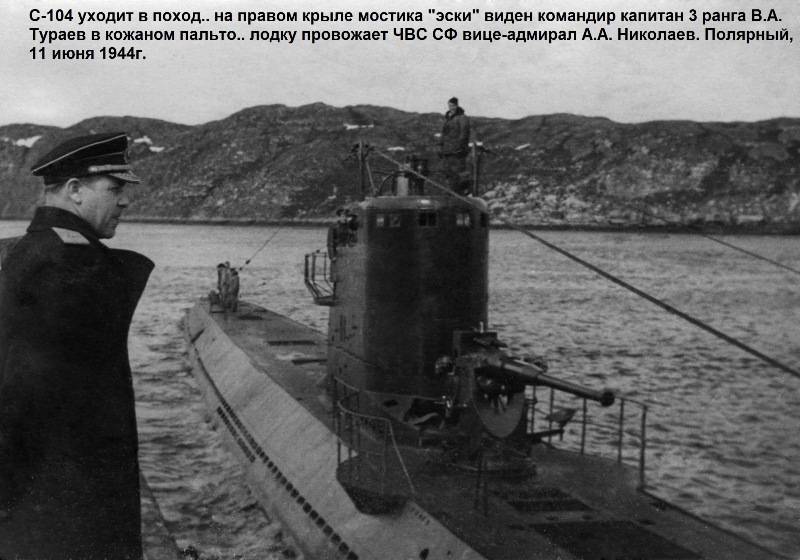
In the disruption of the evacuation of the enemy participated destroyers of the destroyers. So, October 25 in bad weather conditions, the leader of “Baku”, the destroyers “Gremyashchy”, “Reasonable” and “Enraged” entered the search for convoys. Not finding ships and transports, they fired upon the port of Var de, on the territory of which four large fires arose, accompanied by explosions. The activity of the port for a long time was disrupted.
A team of torpedo boats operated from the Pum-manka maneuverable base, which contained up to 22 pennants. Boats were used mainly within the Varanger Fjord. Control was exercised from the command post of the brigade commander located on the Sredniy Peninsula. Independent and joint actions of the groups using naval aviation and free search (“hunting”) in the dark period of the day prevailed. The number of exits to the free search was more than 50 percent. all outputs for the operation, which is mainly due to the limited capabilities of the fleet in the conduct of night intelligence. Torpedo boats sank 4 vehicles (total displacement 18 thousand tons), 4 minesweeper, 4 patrol ships and 1 motorboats. Our losses were 1 torpedo boat.
It should be noted that fleet forces achieved maximum success in the operation at sea when organizing operational and tactical interaction between submarines, surface ships and aircraft. Thus, the 11-12 of October with successive and joint strikes of these forces, a German convoy consisting of 2 transport ships, 2 destroyers and 9 other escort ships that had left Kirkenes, was completely defeated. The last transport destroyed the boat "B-2" near Cape Nordkin in the evening of October 12. Total pilots and sailors for 45 days since September 15 sank more than 190 ships and ships. The Northern Fleet by its actions managed to break enemy naval communications, which greatly helped our ground forces to defeat the enemy. The systematic actions of the fleet did not allow the enemy to regroup the forces by sea. The Nazis suffered significant losses.
It should be noted that civilians of the Murmansk region also made a great contribution to the victory. Many sailors of the fishing fleet and crews of merchant ships, along with military sailors, took part in hostilities, defended naval bases, transported troops and important military cargoes.
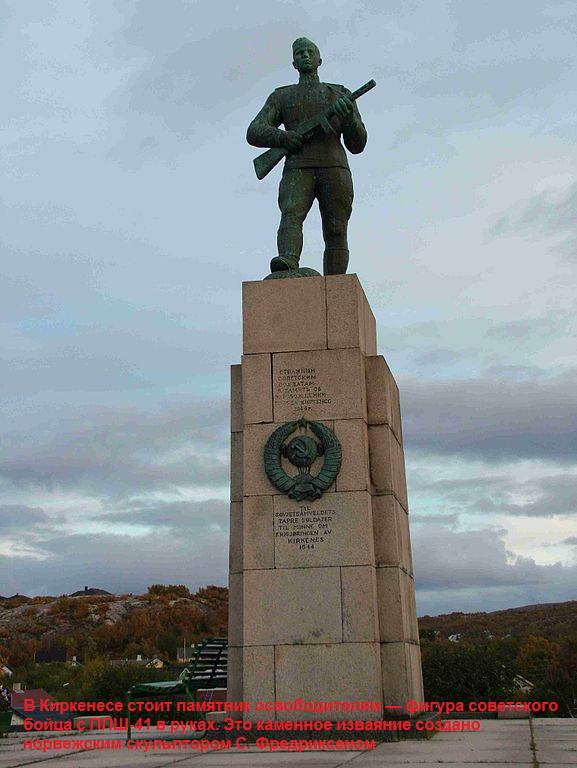
Sources:
Grechanyuk N., Dmitriev V., Kornienko A. and others. Twice Red Banner Baltic Fleet. M .: Voenizdat, 1990. C.248-281.
Rumyantsev M. Defeat of the enemy in the Arctic (1941 — 1944). M .: Voenizdat, 1963. C. 122-143, 187-191, 236-257.
Kozlov I., Shlomin V. Red Banner Northern Fleet. M .: Voenizdat, 1983. C. 154-215.
G. Egorov. The Northern Fleet in the Petsamo-Kirkenes Operation // VIZH. 1973. No.10. C.19-27.
Gorter A., Gorter V., Suprun M. Liberation of East Finnmark, 1944 — 1945 Arkhangelsk - Vadsø: Arkhangelsk Pomor, 2005. C. 24-47.
- Technical engineer
- Liberation of Norway.
The actions of the country's air defense forces during the Petsamo-Kirkenes operation
Forgotten battles. Murmansk offensive operation .
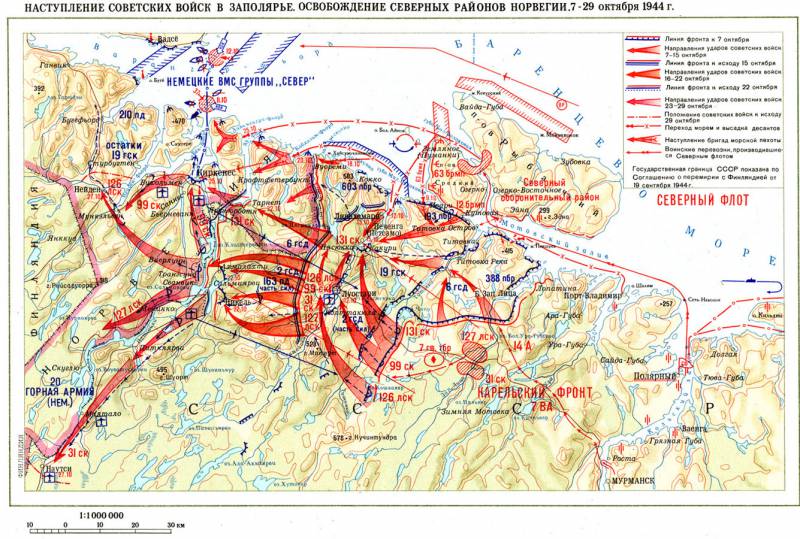
Information